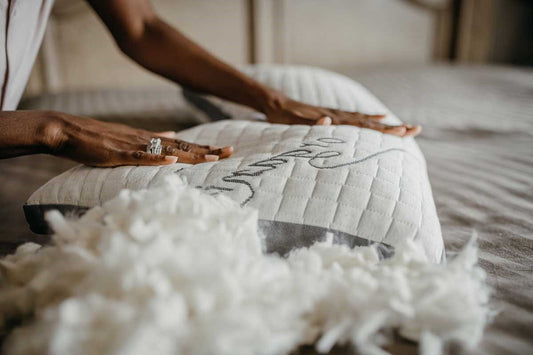Finding the right pillow can make a world of difference in the quality of sleep you get. There are so many pillows on the market though. This can make it more difficult to pick a pillow that is sure to be right. The material a pillow is made of can have a huge impact on whether it’s a good pillow or not. Many people ask us “Which is better, latex or memory foam pillows?” We’ve got answers.
Which is better, latex or memory foam pillows?
What goes into your pillow?
The ingredients in the pillow can have a big impact on whether that pillow is good or not. If the ingredients in your pillow are less than the best, your sleep may also be impacted. When looking at pillows many people will choose between a few varieties. However, the two most common choices are latex or memory foam. But what goes into a latex pillow or a memory foam pillow?
What goes into a latex pillow?
Natural latex is created from the sap of the Hevea brasiliensis rubber tree. It is known most commonly as a more natural alternative to foam. Latex pillows are often considered an organic and green alternative to other types of pillows on the market. With a latex pillow, you will get the benefits of a foam styled mattress with fewer toxins. It’s important to buy from a quality pillow company as some are not as honest about their manufacturing process and you want high-quality latex pillows.
What goes into a memory foam pillow?
Memory foam became a buzz word in the pillow industry and was often known as a good option for those who wanted better sleep. The conversation always stopped there though. Memory foam is made of polyurethane as well as added chemicals. This is meant to increase its viscosity and density. This can offer a pillow with a foam feel that is comfortable for your head. However, memory foam is typically not organic and has more chemicals. So, for more than just a comfort, latex pillows promote better health by using natural ingredients.
Pro Tip - Most companies will have a breakdown of their ingredients and how they are sourced. This will help you to be able to confirm you are picking a quality product.
What type of memory foam or latex is being used?
When choosing a pillow it’s important to understand the types of each ingredient that are being used. While a pillow may promise that it is memory foam or latex, it may have a multitude of variations. This may seem harmless but can actually have a strong impact on the quality of the product. It can also have a huge impact on how the pillow supports your sleep. Here are a few things to ask before buying a new pillow.
Questions to ask about latex or memory foam pillows?
- What kind of latex is being used? - Latex pillows can be made from cross-cut, shredded, or noodled latex. The process of making a latex pillow can vary depending on the manufacturer. Cross-cut latex is the superior option as it is the cleanest and organic way to prepare a pillow. With noodled and shredded latex you are more likely to get dust and extra particles added to your pillow. Choosing a pillow made with organic latex that is cross-cut is sure to increase your overall sleep quality.
- What kind of memory foam is being used? - Some memory foam pillows are made with one solid piece of memory foam. Others are made from a combination of shredded memory foam pieces and fillers. Using a pillow made of memory foam made of one sheet can seem like a safer bet but you will still be exposed to a variety of chemicals used to treat the memory foam. When using a pillow of shredded memory foam, there is no real way of knowing which ingredients you are sleeping on. It is important to look at memory foam and ask yourself if the chemicals being used benefit your sleep and your body.
Pro Tip - When choosing a pillow make sure to accommodate sleeping positions and other needs. Choose a side sleeper pillow or back sleeper pillow to get the best support from the pillow you choose.

Do you have allergies?
One of the biggest difficulties of a good night’s sleep can be allergies. The ingredients in a pillow can work with or against sleep based on how they impact allergies. When choosing a new pillow it will be important to look at how the different ingredients can impact your allergies. It is also important to decide if that pillow will be easy to care for and maintain to protect from allergens. Here are a few things to ask when buying a pillow if you have allergies.
Which pillow type should you choose with allergies?
- How easy is the pillow to clean? - Keeping a pillow clean is a priority when fighting with allergies. Before purchasing a pillow, look at the cleaning process for that pillow. Memory foam pillows can be cleaned but are at a higher risk for issues with the cleaning process. Latex pillows offer a simple cleaning process and offer an organic option that is easy to clean.
- Is the pillow truly hypoallergenic? - When choosing a pillow you will see many promises of a hypoallergenic pillow. The first question you must ask yourself is whether the pillow is genuinely hypoallergenic. With memory foam, there are chemicals used when making pillows from it that could trigger certain allergies. However, most styles of latex pillows will be made from organic materials that should not trigger allergies. Take some time to look at the offerings of each to make sure it is best for your health needs.
- Does the pillow breathe well? - Airflow is important to avoiding some common allergens. When looking at pillows it can help to note that latex pillows breathe up to 7 times better than a memory foam pillow. This air circulation can prevent issues you might encounter with some allergens. When looking at pillows, choose one that is sure to breathe better.
Pro Tip - Adding a hypoallergenic pillowcase can add an extra level of protection to the pillow and for any allergies.





